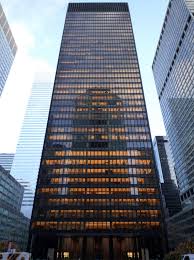International Style
[Seagram Building by Mies van der Rohe]
The International Style was born in western Europe in the 1920s from the innovative work of noted architects Le Corbusier in France, and Walter Gropius and Mies van der Rohe in Germany.
Striving to create a new modern form and functional theory of architecture, these architects abandoned tradition to create a pared down, un-ornamented style that emphasised geometric shapes, viewing it as architecture for the modern age.
Utilising new construction techniques and materials, buildings of the International Style were starkly different than those of previous eras, and not just appearance-wise. Flat roofed, asymmetrical and with bands of windows set into a rectangular form, International Style buildings were a dramatic departure from past eras.
Many European architects came to the United States in the period preceding World War II, bringing their new ideas about modern design with them. In the 1930s, American architects began experimenting with the International Style, building upon the early-20th century American trends like the Commercial, Bungalow and Prairie styles, and the development of skyscrapers.
The influence of the International Style continued long beyond its period of popularity. By creating a new philosophy of architecture dedicated to the pure functionality of form, the International Style had a lasting impact on modern design. Strict observance of the International Style design elements gave way to the development of various modern forms and styles, but the new way of looking at the design of buildings remained.
Pure examples of architect-designed International Style buildings are somewhat rare, but many buildings of the era between 1930-1950 show its influence. Many schools built at the mid century show the basic design principles of the International Style. While the International Style was popular in Europe for residential design in the 1920s and 1930s, it was less commonly used for houses in the United States.
Wealthy followers of the avant garde in architecture commissioned prominent architects to design International Style homes, but the style was not much embraced for more ordinary working class house construction in the USA. However, the design principles of the International Style of functionality and open floor plans could be seen in the tract homes that developed in the post-WWII years.
It is a style that is still in widespread use for tall buildings in cities around the world. It was epitomised by the Twin Towers of New York's World Trade Centre.
Some of the identifiable features of buildings in the International Style include:
- Rectangular forms, often with round projections.
- Flat roof.
- Lack of ornamentation or decorative details.
- Ribbon windows.
- Curtain walls of glass.
- Cantilevered projections.
- Smooth wall surfaces.
- Asymmetrical façade.
This article was written by PHMC.
--Pennsylvania Historical and Museum Commission
[edit] Related articles on Designing Buildings Wiki
- Architectural styles.
- Art Deco.
- Art Moderne.
- Bauhaus.
- Brazilian Modernism lecture.
- Chicago school of architecture.
- Commercial style.
- Contextualism.
- De Stijl.
- Expressionist architecture.
- Form follows function.
- Futurist architecture.
- High-tech architecture.
- Isokon Flats.
- Minimalist architecture.
- Modernist architecture.
- Seagram Building
- Villa Savoye.
Featured articles and news
Government consultations for the summer of 2025
A year of Labour, past and present consultations on the environment, the built environment, training and tax.
CMA competitiveness probe of major housing developers
100 million affordable housing contributions committed with further consultation published.
Homes England supports Greencore Homes
42 new build affordable sustainable homes in Oxfordshire.
Zero carbon social housing: unlocking brownfield potential
Seven ZEDpod strategies for brownfield housing success.
CIOB report; a blueprint for SDGs and the built environment
Pairing the Sustainable Development Goals with projects.
Types, tests, standards and fires relating to external cladding
Brief descriptions with an extensive list of fires for review.
Latest Build UK Building Safety Regime explainer published
Key elements in one short, now updated document.
UKGBC launch the UK Climate Resilience Roadmap
First guidance of its kind on direct climate impacts for the built environment and how it can adapt.
CLC Health, Safety and Wellbeing Strategy 2025
Launched by the Minister for Industry to look at fatalities on site, improving mental health and other issues.
One of the most impressive Victorian architects. Book review.
Common Assessment Standard now with building safety
New CAS update now includes mandatory building safety questions.
RTPI leader to become new CIOB Chief Executive Officer
Dr Victoria Hills MRTPI, FICE to take over after Caroline Gumble’s departure.
Social and affordable housing, a long term plan for delivery
The “Delivering a Decade of Renewal for Social and Affordable Housing” strategy sets out future path.
A change to adoptive architecture
Effects of global weather warming on architectural detailing, material choice and human interaction.
The proposed publicly owned and backed subsidiary of Homes England, to facilitate new homes.
How big is the problem and what can we do to mitigate the effects?
Overheating guidance and tools for building designers
A number of cool guides to help with the heat.
The UK's Modern Industrial Strategy: A 10 year plan
Previous consultation criticism, current key elements and general support with some persisting reservations.
Building Safety Regulator reforms
New roles, new staff and a new fast track service pave the way for a single construction regulator.



























Comments